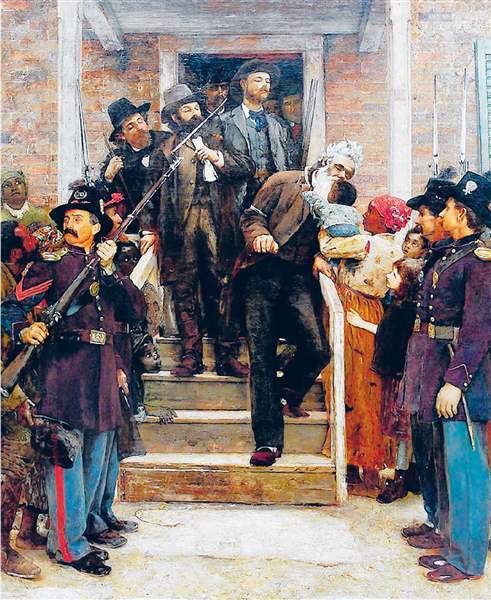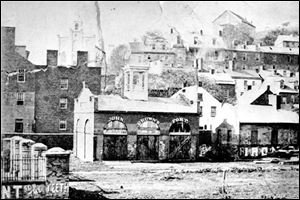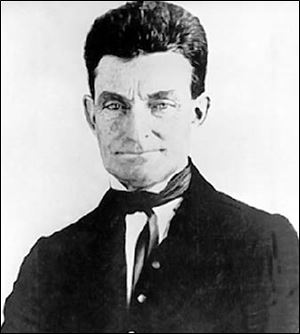
Witness to History: In 1859, Congressman from Toledo chronicled execution of abolitionist
11/29/2009
Thomas Hovenden's painting depicts ‘The Last Moments of John Brown.' The condemned abolitionist had stated his desire to go to the gallows ‘if possible, [with] some good old Slave Mother and her children, weeping and praying to the God of all to receive my soul.'
![Witness-to-History-In-1859-Congressman-from-Toledo-chronicled-execution-of-abolitionist.jpg Thomas Hovenden's painting depicts ‘The Last Moments of John Brown.' The condemned abolitionist had stated his desire to go to the gallows ‘if possible, [with] some good old Slave Mother and her children, weeping and praying to the God of all to receive my soul.'](/image/2009/11/29/300x_b1a4-3_cCM/Witness-to-History-In-1859-Congressman-from-Toledo-chronicled-execution-of-abolitionist.jpg)
Thomas Hovenden's painting depicts ‘The Last Moments of John Brown.' The condemned abolitionist had stated his desire to go to the gallows ‘if possible, [with] some good old Slave Mother and her children, weeping and praying to the God of all to receive my soul.'
“Now, that the old man is gone, what will be said of him? Who shall reconcile the conflicting statements? What will be the verdict of history?''
One hundred and fifty years ago, James Mitchell Ashley, through The Daily Blade, attempted to play some role in answering that question after personally witnessing rogue abolitionist John Brown's hanging on Dec. 2, 1859, for treason for his ill-fated attack on a federal arsenal at Harpers Ferry, Va. (now West Virginia).
The 35-year-old Republican freshman congressman from Toledo, who later authored the 13th Amendment abolishing slavery and, with President Abraham Lincoln, ushered the amendment through Congress, entered what was then Charlestown, Va., with Mrs. Brown to meet with her husband.
Brown had hoped his attack on nearby Harpers Ferry on Oct. 16 would ignite the spark that ultimately would end slavery in a bitterly divided United States. It did not take forces led by Col. Robert E. Lee long to recapture the armory and apprehend Brown. It would be another year and a half before the official start of the Civil War.
In an article published on Dec. 9, 1859, in The Daily Blade, gleaned from written accounts he'd given his family, Mr. Ashley wrote about how he described the execution he'd just witnessed to Brown's grieving widow, Mary Ann Day Brown. She had married Brown soon after his first wife died in childbirth. The second Mrs. Brown bore her husband 13 more children.

John Brown and his armed band of raiders eventually were captured after holing up in a fire engine and guard house at the entrance to the federal armory at Harpers Ferry.
Attendance near the gallows the day of the execution was heavily restricted. Mrs. Brown, who had traveled from New York via Philadelphia, did not attend, so Mr. Ashley reported to her what he saw:
“ … I told her how like a man he acted — and how like a hero he died — and that to the question again asked him, if he ‘desired the services of a clergyman,' he replied, ‘No. I do not desire the prayers of any minister who approves of the enslavement of one of God's children,' and added, ‘I want to go to the scaffold only in company with the necessary officers of the law, and if possible, some good old Slave Mother and her children, weeping and praying to the God of all to receive my soul.'”
Mr. Ashley, the great-grandfather of Thomas “Lud” Ashley who represented Toledo in Congress from 1955 to 1981, is under consideration by a state legislative panel as a possible replacement for Gov. William Allen in the National Statuary Hall in Washington. In tune with many Ohio Democrats of his time, Allen's tolerance for slavery and his opposition to President Lincoln and the Civil War have prompted the state to regret his placement as one of two commemorations of Ohio in the U.S. Capitol.
The committee is expected to make its recommendation early next year from a list that also includes inventor Thomas Edison; Olympic athlete Jesse Owens; the two Wright Brothers; Cincinnati Reds player Dummy Hoy, the most famous deaf professional baseball player; Presidents William McKinley, William Howard Taft, and Ulysses S. Grant; Tecumseh, the Shawnee leader who fought the United States during the War of 1812, and suffragette Harriet Taylor Upton.
Sandra Weber of Lansdale, Pa., wrote of Mrs. Brown in her 2004 book, Breaking Trail: Remarkable Women of the Adirondacks, and portrays her in interpretative programs. She wasn't aware of Mr. Ashley's role on the day of Brown's execution but said his accounts are largely consistent with what is known of Brown's last days.

Brown, shown two years earlier, hoped the attack would ignite the spark that ultimately would end slavery.
“[Mrs. Brown] was dismissed as an ignorant woman who just followed him and did what he said,” Ms. Weber said. “She's been left out of the whole story for the most part. But I have found over 40 letters from her that show she was educated and involved in the issues, especially letters she wrote after his hanging. She continued to be involved in the abolition movement.
“When he was in jail, it was proposed that if they could prove he was insane, they could save his life,” Ms. Weber said. “But she stood up and said you can't say that because it isn't true. By doing that and backing up everything he was saying at the time, she preserved the persona of John Brown, preserved the legend.”
In his letters, Mr. Ashley described how Mrs. Brown, upon her arrival in Charlestown, suffered the indignation of being stripped and searched for fear she might sneak a poison or some other implement of suicide to her husband.
“Nothing, however, was discovered on or about her person more formidable or dangerous than ladies usually wear, and she was permitted a moment alone, although the jail was guarded by at least a thousand soldiers and five brass cannon,” Mr. Ashley wrote. “The pretext that Mrs. B might, notwithstanding the search, give him something with which to commit suicide, is simply preposterous. John Brown's whole life and every act from the day of his arrest until that hour, was a guaranty against his committing self-murder.”
He described watching as Mr. Brown was led from the prison to a wagon that would carry him to the gallows.
“…[A] slave woman, having perhaps heard me spoken of as an Abolitionist, said in my hearing, and I suppose so that I should hear it, just as the old man seated himself on his coffin, ‘God bless you, old man; if I could help you, I would; but I can't.' The countenances of all the slaves told too plainly of their sympathy.”
History remains perplexed about Brown. Was he the hero that Ashley described seven days after Brown's execution or a mad man? Even Ashley admitted to some conflict.
“Simple in his manners, and with but few wants, he lived only to help the helpless,” Ashley wrote. “However much I condemn and lament, as I most sincerely do, his attack on this place, I cannot but admire his heroism, his straight-forward independence, and his undoubted courage.”
Contact Jim Provance at:jprovance@theblade.comor 614-221-0496.